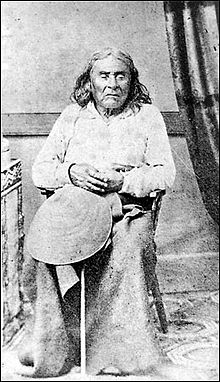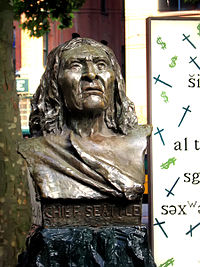- Chief Seattle
-
Seattle 
The only known photograph of Chief Seattle, taken 1864Tribe Duwamish Born c. 1780
On or near Blake Island, WashingtonDied June 7, 1866
Port Madison, WashingtonNative name Si'ahl Known for Namesake of city of Seattle Resting place Port Madison, Washington Religious beliefs Roman Catholic Children Princess Angeline Chief Seattle (an Anglicization of Si'ahl), (Lushootseed pronunciation: [ˈsiʔaːɬ], originally [ˈsiʔaːtɬʼ];[1] c. 1780 - June 7, 1866) was a Dkhw’Duw’Absh (Duwamish) chief,[2] also known as Sealth, Seathle, Seathl, or See-ahth. A prominent figure among his people, he pursued a path of accommodation to white settlers, forming a personal relationship with David Swinson "Doc" Maynard. Seattle, Washington was named after him. A widely publicized speech arguing in favor of ecological responsibility and respect of native Americans' land rights has been attributed to him; however there is controversy about what, if anything, he actually said.[1]
Contents
Biography
Si’ahl's mother Sholeetsa was Dkhw’Duw’Absh (Duwamish) and his father Shweabe was chief of the Dkhw’Suqw'Absh (the Suquamish tribe).[2] Si’ahl was born around 1780 on or near Blake Island, Washington. One source cites his mother's name as Wood-sho-lit-sa.[3] The Duwamish tradition is that Si’ahl was born at his mother's Dkhw’Duw’Absh village of Stukw on the Black River, in what is now the city of Kent, and that Si'ahl grew up speaking both the Dkhw’Duw’Absh and Dkhw’Suqw'Absh dialects of Lushootseed. Because Native descent among the Salish peoples was not solely patrilineal, Si'ahl inherited his position as chief of the Dkhw’Duw’Absh or Suquamish Tribe from his maternal uncle.[2] In later years, Si’ahl claimed to have seen the ships of the Vancouver Expedition as they explored Puget Sound.
Si’ahl earned his reputation at a young age as a leader and a warrior, ambushing and defeating groups of enemy raiders coming up the Green River from the Cascade foothills, and attacking the Chimakum and the S'Klallam, tribes living on the Olympic Peninsula. Like many of his contemporaries, he owned slaves captured during his raids. He was tall and broad for a Puget Sound native at nearly six feet; Hudson's Bay Company traders gave him the nickname Le Gros (The Big One). He was also known as an orator; and when he addressed an audience, his voice is said to have carried from his camp to the Stevens Hotel at First and Marion, a distance of 3/4 of a mile.[3]
He took wives from the village of Tola'ltu just southeast of Duwamish Head on Elliott Bay (now part of West Seattle). His first wife La-Dalia died after bearing a daughter. He had three sons and four daughters with his second wife, Olahl.[3] The most famous of his children was his first, Kikisoblu or Princess Angeline. Si’ahl was baptized in the Roman Catholic Church, and given the baptismal name Noah, probably in 1848 near Olympia, Washington.[4] The meaning of this ceremony may be called into question by his references to his people's gods in his most famous Talk (below).
For all his skill, Si’ahl was gradually losing ground to the more powerful Patkanim of the Snohomish when white settlers started showing up in force. When his people were driven from their traditional clamming grounds, Si’ahl met Maynard in Olympia; they formed a friendly relationship useful to both. Persuading the settlers at Duwamps to rename the town Seattle, Maynard established their support for Si’ahl's people and negotiated relatively peaceful relations among the tribes.
Si’ahl kept his people out of the Battle of Seattle (1856). Afterwards, he was unwilling to lead his tribe to the reservation established, since mixing Duwamish and Snohomish was likely to lead to bloodshed. Maynard persuaded the government of the necessity of allowing Si’ahl to remove to his father's longhouse on Agate Passage, 'Old Man House' or Tsu-suc-cub. Si’ahl frequented the town named after him, and had his photograph taken by E. M. Sammis in 1865.[3] He died June 7, 1866, on the Suquamish reservation at Port Madison, Washington.
Legacy
 Statue (erected 1908) of Chief Seattle, Tilikum Place, Seattle, Washington. The statue is on the National Register of Historic Places.
Statue (erected 1908) of Chief Seattle, Tilikum Place, Seattle, Washington. The statue is on the National Register of Historic Places.
- Si’ahl's grave site is at the Suquamish Tribal Cemetery.[5]
- In 1890, a group of Seattle pioneers led by Arthur Armstrong Denny set up a monument over his grave, with the inscription "SEATTLE Chief of the Suqampsh and Allied Tribes, Died June 7, 1866. The Firm Friend of the Whites, and for Him the City of Seattle was Named by Its Founders" On the reverse is the inscription "Baptismal name, Noah Sealth, Age probably 80 years."[3] The site was restored and a native sculpture added in 1976 and again in 2011.
- Soundgarden, a Seattle rock band, covered the Black Sabbath song, "Into the Void" replacing the lyrics with the words from Chief Seattle's speech.
- The Suquamish Tribe honors Chief Seattle every third week in August at "Chief Seattle Days".
- The city of Seattle, and numerous related features, are named after Si’ahl.
- A B-17E Flying Fortress named Chief Seattle, a so-called "presentation aircraft", was funded by bonds purchased by the citizens of Seattle. Flying with the 435th Bombardment Squadron in the defense of Port Moresby, it was lost with its 10-man crew on August 14, 1942.[6][7]
The Speech controversy
There is a controversy about a speech by Si’ahl concerning the concession of native lands to the settlers.
Even the date and location of the speech has been disputed,[8] but the most common version is that on March 11, 1854, Si’ahl gave a speech at a large outdoor gathering in Seattle. The meeting had been called by Governor Isaac Ingalls Stevens to discuss the surrender or sale of native land to white settlers. Doc Maynard introduced Stevens, who then briefly explained his mission, which was already well understood by all present.[3]
Si’ahl then rose to speak. He rested his hand upon the head of the much smaller Stevens, and declaimed with great dignity for an extended period. No one alive today knows what he said; he spoke in the Lushootseed language, and someone translated his words into Chinook jargon, and a third person translated that into English.
Some years later, Dr. Henry A. Smith wrote down an English version of the speech, based on Smith's notes. It was a flowery text in which Si’ahl purportedly thanked the white people for their generosity, demanded that any treaty guarantee access to Native burial grounds, and made a contrast between the God of the white people and that of his own. Smith noted that he had recorded "...but a fragment of his [Sealth's] speech". Recent scholarship questions the authenticity of Smith's supposed translation.[9][verification needed]
In 1891, Frederick James Grant's History of Seattle, Washington reprinted Smith's version. In 1929, Clarence B. Bagley's History of King County, Washington reprinted Grant's version with some additions. In 1931, John M. Rich reprinted the Bagley version in Chief Seattle's Unanswered Challenge. In the 1960s, articles by William Arrowsmith and the growth of environmentalism revived interest in Si’ahl's speech. Ted Perry introduced anachronistic material, such as shooting buffalo from trains, into a new version for a movie called Home,[1] produced for the Southern Baptist Radio and Television Commission.[10] The movie sank without a trace, but this newest and most fictional version is the most widely known. Albert Furtwangler analyzes the evolution of Si’ahl's speech in Answering Chief Seattle (1997).[11]
The speech attributed to Si’ahl, as re-written by others, has been widely cited as "powerful, bittersweet plea for respect of Native American rights and environmental values".[1] A similar controversy surrounds a purported 1855 letter from Si’ahl to President Franklin Pierce, which has never been located and, based on internal evidence, is considered by some historians as "an unhistorical artifact of someone's fertile literary imagination".[8]
See also
- Battle of Seattle (1856)
- History of Seattle before 1900
- Chief Sealth International High School
- Suquamish Museum and Cultural Center
Notes
- ^ a b c d Chief Seattle, Section: Pronouncing Chief Seattle's Name, 2003-2007, HistoryLink.org Essay 5071. Accessed 2010-04-21. This article includes a sound file of the late Skagit Elder Vi Hilbert demonstrating the correct pronunciation of Si'ahl's name. For the speech controversy emanating from Smith, see the article section entitled "Known for a City and a Speech."
- ^ a b c "Chief Si'ahl and His Family". Culture and History. Duwamish Tribe. http://www.duwamishtribe.org/chiefsiahl.html. Retrieved 2009-09-24.
- ^ a b c d e f *Emily Inez Denny:] (1899). Blazing the Way (reprinted 1984 ed.). Seattle Historical Society.
- ^ "Chief Seattle and Chief Joseph: From Indians to Icons", by David M. Buerge
- ^ "Suquamish Culture". Suquamish Tribe. http://www.suquamish.nsn.us/. Retrieved July 1, 2007.
- ^ "Chief Seattle" and Crew. http://books.google.com/books?id=SlHUI_wWgGAC&pg=PA415&lpg=PA415&dq=435TH+BOMB+SQUADRON&ct=result#PPA454,M1. Retrieved December 27, 2008.
- ^ *Gene Eric Salecker (2001). Fortress Against the Sun bob. Da Capo Press. 978-1580970495.
- ^ a b Jerry L. Clark (Spring, 1985). "Thus Spoke Chief Seattle: The Story of An Undocumented Speech". The National Archives. http://www.archives.gov/publications/prologue/1985/spring/chief-seattle.html. Retrieved July 1, 2007.
- ^ BOLA Architecture + Planning & Northwest Archaeological Associates, Inc., Port of Seattle North Bay Project DEIS: Historic and Cultural Resources, Port of Seattle, April 5, 2005. Accessed online 25 July 2008. p.
- ^ "Territorial Governor Isaac Stevens & Chief Seattle", Museum of History and Industry, Seattle, Wash., June, 1990; reprinted on The eJournal Website
- ^ Furtwangler, Albert (1997). Answering Chief Seattle. University of Washington Press. http://books.google.com/books?id=GaNRJF6zQAAC&dq=&pg=PP1&prev=http://www.google.com/search%3Fq%3Danswering%2Bchief%2Bseattle%26sourceid%3Dnavclient-ff%26ie%3DUTF-8%26rlz%3D1B3GGGL_enUS177US231. Retrieved August 31, 2007.
References
- Lakw’alas (Thomas R. Speer), The Life of Si’ahl, ‘Chief Seattle’, Duwamish Tribal Services Board of Directors, for the Duwamish Tribe, July 22, 2004.
- Murray Morgan, Skid Road, 1951, 1960, and other reprints, ISBN 0-295-95846-4.
- William C. ("Bill") Speidel, Doc Maynard, The Man Who Invented Seattle, Nettle Creek Publishing Company, Seattle, 1978.
- Chief Seattle bio, Chief Seattle Arts, accessed online 2009-02-23.
- Brief analysis of the different versions of the speech by Nancy Zussy, Librarian, Washington State Library, accessed online 2010-01-01.
- The Suquamish Museum (1985). The Eyes of Chief Seattle. Suquamish, WA: Suquamish Museum.
- Jefferson, Warren (2001). The World of Chief Seattle, How Can One Sell the Air?. Summertown, TN: Native Voices. pp. 127. ISBN 1-57067-095-1.
External link
- Suquamish Museum & Cultural Center
 "Seattle". Appletons' Cyclopædia of American Biography. 1900.
"Seattle". Appletons' Cyclopædia of American Biography. 1900.
Categories:- 1780s births
- 1866 deaths
- People celebrated in the Lutheran liturgical calendar
- Native American leaders
- History of indigenous peoples of the Pacific Northwest
- Pre-state history of Washington (state)
- History of King County, Washington
- Anglican saints
Wikimedia Foundation. 2010.



